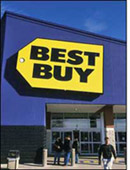May 14, 2005dary of RFID adoption beyond the tagging of pallets and cases employed by Wal-Mart, Target, Tesco and other retail chains. The company’s vision is to tag individual items and thereby increase efficiency, expand product availability and provide real-time information to suppliers.
Best Buy also believes that item-level tagging will ultimately improve the shopping experience. Paul Freeman, RFID program director at Best Buy, sees a day when tagged products line store shelves, and RFID readers and antennas mounted on pillars throughout the stores track and trace nearly the entire in-store inventory. RFID could help salespeople locate products that were inadvertently moved by a customer. “We want to help our customers find the products
faster and check them out quicker,” Freeman says. “We want to be able to have the customer easily understand that these three or four products go together as a bundled solution. We envision a lot better customer service down the road.”
But first Best Buy has to get its pallet- and case-tagging operation up and running. (Some large items, such as TVs or computers, come in their own cases.) For now, the company is following EPCglobal guidelines for tagging pallets and cases, and its requirements for suppliers are similar to those issued by Wal-Mart and Target. Suppliers can use tags based on the Electronic Product Code standards.
Best Buy’s major suppliers—accounting for 80 percent of the merchandise sold in its 650 stores—are expected to begin tagging pallets and cases by Jan. 2, 2006. All pallets and cases are to be tagged by May 2007. The company expects to release a timeline for item-level tagging this summer. Later this year, Best Buy will begin a pilot phase in select stores and a specific distribution center to test and tune its pallet and case RFID implementation (the company isn’t identifying the locations of those facilities at this time).
Best Buy is taking pains to work with suppliers to help them see the potential return on investment from being able to track their products, trace sales and allocate manufacturing resources based on up-to-date data. There is, however, another potential gain for suppliers. “We really want to move with them and make this successful,” says Freeman. “If we all get converted off of the bar code as soon as possible, we reduce the cost of running dual systems.”

